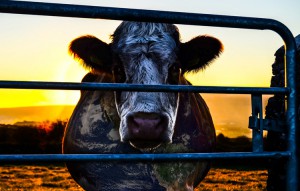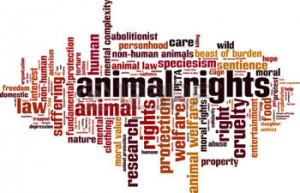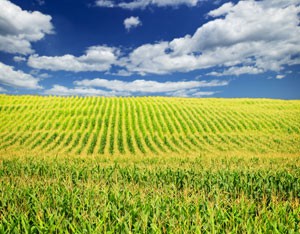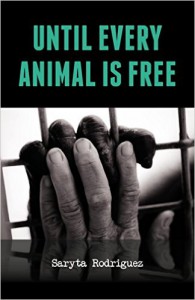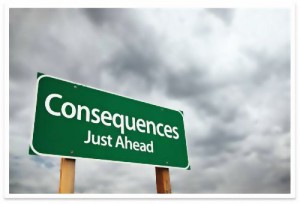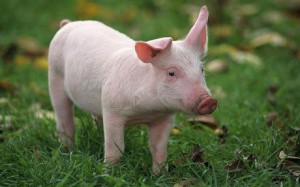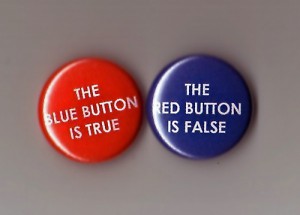 (This blog first appeared as an article for ARZone)
(This blog first appeared as an article for ARZone)
In recent years there has been increasing popularity within the mainstream animal ‘rights’ movement to try and bridge gaps between different ideas in the animal movement. This has frequently led to privileging certain approaches that are not rights based, as they tend to be more accessible to people currently consuming animals, and the mainstream groups correctly point out that people consuming animals largely constitute our audience. However, there are a number of issues which need to be taken into account when we are advocating for animals that strengthen or weaken our advocacy. So how we approach advocacy is important in regard to the claims that we make. One approach that has recently gained traction relates to ‘carnism‘, and this has been described by Will Tuttle as a concept which is ‘important and empowering; it uniquely names and illumines what has been virtually invisible in our culture’s most defining attitudes and practices.’ The central tenet of carnism is that we are conditioned to eat certain animals, and this provides a useful starting point for discussions around animal exploitation, whilst the ideology surrounding carnism can also help us examine the behaviour of ‘carnists’.
There are however, some issues with the ideology of carnism that shouldn’t be overlooked. So if we are going to use aspects of this ideology to inform our advocacy, then it is also worth reflecting on its limitations. One such issue is where we identify carnism as being ‘food choice’ oriented, and how veganism has consequently been reduced to a diet (where other vegan implications are missing), and this is a general reflection of how the mainstream animal movement presents a diminished view of veganism. It is also more accurate to say that veganism is the opposite to speciesism, rather than the opposite to carnism. As carnism is considered a ‘sub-ideology’, then it follows that veganism can deal with carnism within its broader scope, so there is no need to limit the philosophy of veganism in regard to carnism. A particular consequence of this approach could be a dietary or personal purity response instead of invoking the broader social intentions surrounding the original idea of veganism, rooted in opposition to animal exploitation and the pursuit of social justice. If anything, a plant based diet is the opposite to carnism, or even vegetarianism which has been stated on the Beyond Carnism website and in itself would address ‘meat’ consumption.
With these issues in mind, there is one particular aspect of carnism that sought to illuminate an attempt to protect the social conditioning of animal exploitation, and this takes place through the process that has been called neocarnism.
The main function of neocarnism ‘is to provide rational arguments (carnistic justifications) to invalidate veganism—primarily by invalidating the three pillars of the vegan argument: animal welfare/rights, the environment, and human health.’
The presence of people with neocarnist attitudes isn’t anything particularly new in animal rights / vegan / anti-speciesist spaces, as many people that are transitioning toward veganism exhibit these attitudes and behaviours. However, there are also neocarnists that have rejected veganism, such as Lierre Keith and Rhys Southan who were ‘vegan’, but now attempt to argue against a vegan position. Whilst we can also recognise there are many people who are vegan that continue to exhibit speciesist traits due to the extent we have been socially conditioned to devalue other animals in our everyday lives. This is exemplified by a continual process or ‘journey’ when people arrive at veganism.
Whilst there are traditional neocarnists who undermine the pillars of veganism, there are also ‘professionals’ within the mainstream ‘vegan’ advocacy movement that express neocarnist traits, and this theme seems to have gained momentum as it has facilitated a disconnect from philosophy or theory (Regan and Cross for instance), and has paved the way for what is enigmatically termed an ‘effective approach’. The potential negative consequences of taking this approach aren’t evaluated from within that part of the animal movement, and when attention is drawn to neocarnist implications they are often reflexively dismissed or ignored. For everyone else, it is important that we look at the central aspects of neocarnism to better understand the process that is taking place, and in this way we can begin to identify that process in the mainstream animal ‘rights’ movement. For example, there are two points from this article on neocarnism that particularly stand out:
‘The danger of the neocarnisms is that they offer themselves as a solution to a problem that they cannot solve—and they therefore become attractive alternatives to those who might otherwise support veganism. The neocarnisms act as a carnistic safety net: those who seek to step outside of carnism land in another version of the system, thinking that they’ve reconciled the irreconcilable conflict between caring about and harming other beings. [For example ‘humane meat’]
The process of the neocarnisms can be seen through their purpose: the purpose of each argument is not to engage with the issue of veganism but to defend against it. The arguments do not reflect openness to further exploration of the issue or a desire to seek alternatives to killing. They do not serve to invite dialogue but rather to shut down the conversation by invalidating veganism as abnormal, unnatural, and unnecessary. The process reflects a black-and-white, rigid reactiveness rather than a nuanced and flexible responsiveness—a healthy process encourages true examination of one’s own assumptions as well as witnessing and validation of different perspectives.’
Beyond Carnism or ‘Within Carnism’?
This leads to the question of whether the mainstream movement actually counters carnism or whether in many ways it reinforces neocarnism and subsequently animal exploitation through making claims of ‘effectiveness’ (this is often what is meant with the claim ‘meeting people where they are at’, which we can do, but without validating animal exploitation). An example of neocarnism could be support for reducetarianism, an approach where animals are considered ‘meat’, and where it is ok to exploit and consume them. In this way reducetarianism represents a case of neocarnism undermining the pillars of veganism. However, as neocarnist ideology says, we need to ensure that we ‘continue to challenge such proponents to reflect more deeply on their choices.’ Of course the way we do this is important, and the recent book by Casey Taft outlines how we can advocate in a way that supports veganism and animal rights. Otherwise, where we support neocarnist organisations we end up reinforcing carnism regardless of what claims we make based on our own personal ‘veganism’ (perhaps more accurately defined in some parts of the mainstream movement as ‘highly effective reducetarianism’). So in this regard it is important to examine the implications of ‘professional’ animal advocates supporting neocarnist approaches, especially in relation to how vegan recidivism could be facilitated through recuperation, and how this approach would have a detrimental impact on a social justice* framework.
So it is important to be clear that veganism would reject neocarnism within the mainstream animal advocacy movement *because* there is the need to challenge people to reflect more deeply on their carnism, rather than taking an approach that soothes carnists with mainstream tropes such as veganism being ‘extreme’, which in itself is a skewed representation of people who adopt and advocate veganism as it is defined.** This has also been presented as ‘orthodox’ or ‘dogmatic’ by the mainstream animal movement, when in fact it is ‘just’ veganism.
It also becomes apparent that claims from Beyond Carnism have not been sufficiently evaluated, whilst new initiatives such as CEVA (Centre for Effective Vegan Advocacy and an offshoot of Beyond Carnism) present a further issue in regard to neocarnism, where there could be a preference for utilising neocarnism ‘strategically’ (under the guise of making veganism appear ‘easier’) rather than making a sound case for veganism. In this way the organisation would most likely encourage neocarnist reducetarianism in line with the ‘strategies’ of one of their contributors, rather than recommending a sound vegan, animal rights and anti-speciesist approach to effective vegan advocacy.
Notes.
*The social justice implications require a separate discussion in regard to carnism. Utilising the system of carnism or speciesism ‘strategically’ has the effect of undermining vegan and animal rights advocacy and is highly problematic when opposing exploitation and oppression as part of an intersectional justice approach. A further problem is where ‘effective’ activists would counter this issue by applying their method to other oppressed groups.
In regard to animal advocacy the mainstream ‘strategies’ attempt to occupy the neocarnist space and really have nothing to do with advocating veganism. Although people attempt to bridge the ‘gap’ between veganism and neocarnism, denigrating vegans and veganism would hardly be considered an effective and encouraging approach. Instead, it would merely reinforce a neocarnist response and sets up veganism / animal rights as a problem rather than a solution.
There are issues in vegan advocacy and veganism that need addressing, but this needs to take place in an encouraging and supportive way.
Reducetarianism is sometimes confused with reduction. When we become vegan we reduce the amount of animals we exploit. In advocacy terms this means from a vegan or rights based perspective, so we look at how to do that. Whereas reducetarianism uses a carnist perspective that says it is ok to consume animals, though we ought to consume less of them.
** “A philosophy and way of living which seeks to exclude—as far as is possible and practicable—all forms of exploitation of, and cruelty to, animals for food, clothing or any other purpose; and by extension, promotes the development and use of animal-free alternatives for the benefit of humans, animals and the environment. In dietary terms it denotes the practice of dispensing with all products derived wholly or partly from animals.” https://www.vegansociety.com/go-vegan/definition-veganism
Links.
Motivational Methods for Vegan Advocacy: A Clinical Psychology Perspective, by Casey Taft
The Vegan Publishers blog
Information about vegan advocacy – TAVS
What’s Wrong with Carnism, by Corey Lee Wrenn
[i] “A philosophy and way of living which seeks to exclude—as far as is possible and practicable—all forms of exploitation of, and cruelty to, animals for food, clothing or any other purpose; and by extension, promotes the development and use of animal-free alternatives for the benefit of humans, animals and the environment. In dietary terms it denotes the practice of dispensing with all products derived wholly or partly from animals.”

